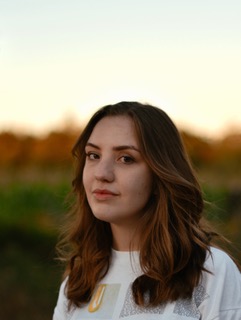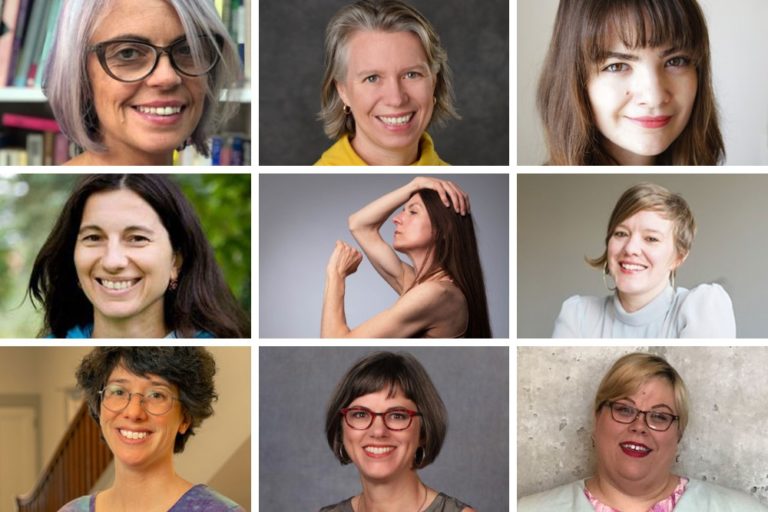Three College of Arts & Letters students earned first-place awards for their presentations at Michigan State University’s 24th Annual University Undergraduate Research and Arts Forum (UURAF). The students are now among the other first-place winners who will be considered for the grand prize, which will be announced in June.

The three first-place winners from the College of Arts & Letters include:
- Sarah Knappenberger, senior Linguistics major
- Emma Stoolmaker, senior Art Education major
- Alex Vonhof, senior Studio Art major
The 2022 UURAF hosted more than 750 undergraduate students from 14 different colleges and academic units. In addition to the outstanding student participation, more than 500 faculty, staff, post-doctoral fellows, graduate students, and industry partners, mentored students in their various research projects. Of those undergraduate students, 24 of them were from the College of Arts & Letters, in addition to the numerous College of Arts & Letters faculty involved.
This year’s hybrid UURAF consisted of poster, oral, and performance/showcase presentations that took place both virtually and in person at the Breslin Student Events Center on April 8. As their research was evaluated by judges, students were given the experience of sharing their research with faculty, staff, peers, and external audiences from across Michigan State University and beyond.

The following gives more information about the first-place winners from the College of Arts & Letters and their research:
Sarah Knappenberger
Knappenberger received first place in the Linguistics, Languages, and Speech category for her poster presentation, titled “Lexical Access and Production in Michigan English.” Her mentor for the project was Karthik Durvasula, Assistant Professor in the Department of Linguistics, Languages, and Cultures.

“Research shows that subsequent iterations of a word have shorter durations than words that are introduced for the first time in the context of the communication,” Knappenberger wrote. “After the first utterance of a word, the activation threshold is lower. Consequently, it can be accessed and processed more easily. This in turn could allow for the word duration to be shortened.”
“After the first utterance of a word, the activation threshold is lower. Consequently, it can be accessed and processed more easily.”
Sarah Knappenberger
Knappenberger probed this question through a lexical priming paradigm. In this experiment, participants produced a series of unprimed stimuli and a series of primed stimuli. A comparison of the durations of primed and unprimed utterances showed no observable effect of priming on word production.
Alex Vonhof
Vonhof received first place in the Visual and Performing Arts category for his performance presentation titled “Environments,” which is an ongoing research project, culminating in a series of sound performances, exploring humanity’s desecration of the natural space and the concurrent reliance on and commercial reproduction of the psychologically beneficial aspects of our world. His mentor was Lorelei Jones, Assistant Professor in Electronic Art & Intermedia in the Department of Art, Art History, and Design.

“The advancement of our society and technology has led us on a path that diverges from nature and destroys it at the same time,” Vonhof wrote. “The performance is a manipulation of an Environments record, titled The Psychologically Ultimate Seashore. This manipulation of the soundscape recording is a reflection of our treatment of the natural world and directly counters the intended psychological effect of the record: to give us temporary reprieve from the sounds and complexity of modern life.”
“This manipulation of the soundscape recording is a reflection of our treatment of the natural world and directly counters the intended psychological effect of the record: to give us temporary reprieve from the sounds and complexity of modern life.”
Alex Vonhof
The piece begins with the soundscape as originally recorded, and throughout the duration of the performance, Vonhof utilizes a mixer, a delay and reverb pedal, and a distortion pedal to create a different version of the soundscape, one that’s dark and distorted, bearing only the slightest resemblance to the original recording. This piece demands recognition of the ways that we treat our world.
Emma Stoolmaker
Stoolmaker received first place in the Visual and Performing Arts category for her oral presentation, titled “By her hand: An investigation of gender and class through the decorative (or fine?) arts in studio practice.” Her mentor was d’Ann de Simone, a Professor in the Department of Art, Art History, and Design.

In 2007, the Museum of Art and Design in Manhattan exhibited “Radical Lace and Subversive Knitting” to showcase the ways in which fiber artists situate their work within the broader scope of contemporary art. Historically, textiles and other forms of decorative art have been relegated classification outside of what is considered to be “fine art,” that which utilizes a focused degree of “craft” and often indicates a particular function aside from being viewed.
“This type of work has strong associations with groups of working-class women on a global scale, often serving as a vehicle to narrate the gendered and class struggles for generations,” Stoolmaker wrote. “Considering the words of David McFadden, who questioned ‘How does something as innocent and harmless as knitting become subversive? I explore how the decorative arts instigate subversion and maintain relevance in the contemporary art scene while still upholding the rich and complex histories of its former participants.”
“How does something as innocent and harmless as knitting become subversive?”
Emma Stoolmaker
Working closely with de Simone, Stoolmaker assisted in the creation and dissemination of bodies of work that promote the reclamation of decorative arts within a contemporary context. They question the ideologies, traditions, and visual signifiers passed down through generations of artists and what might be gleaned from those (namely non-male, working-class) makers who are still often distinguished from “fine artists.”
Written by Hannah Diggs


